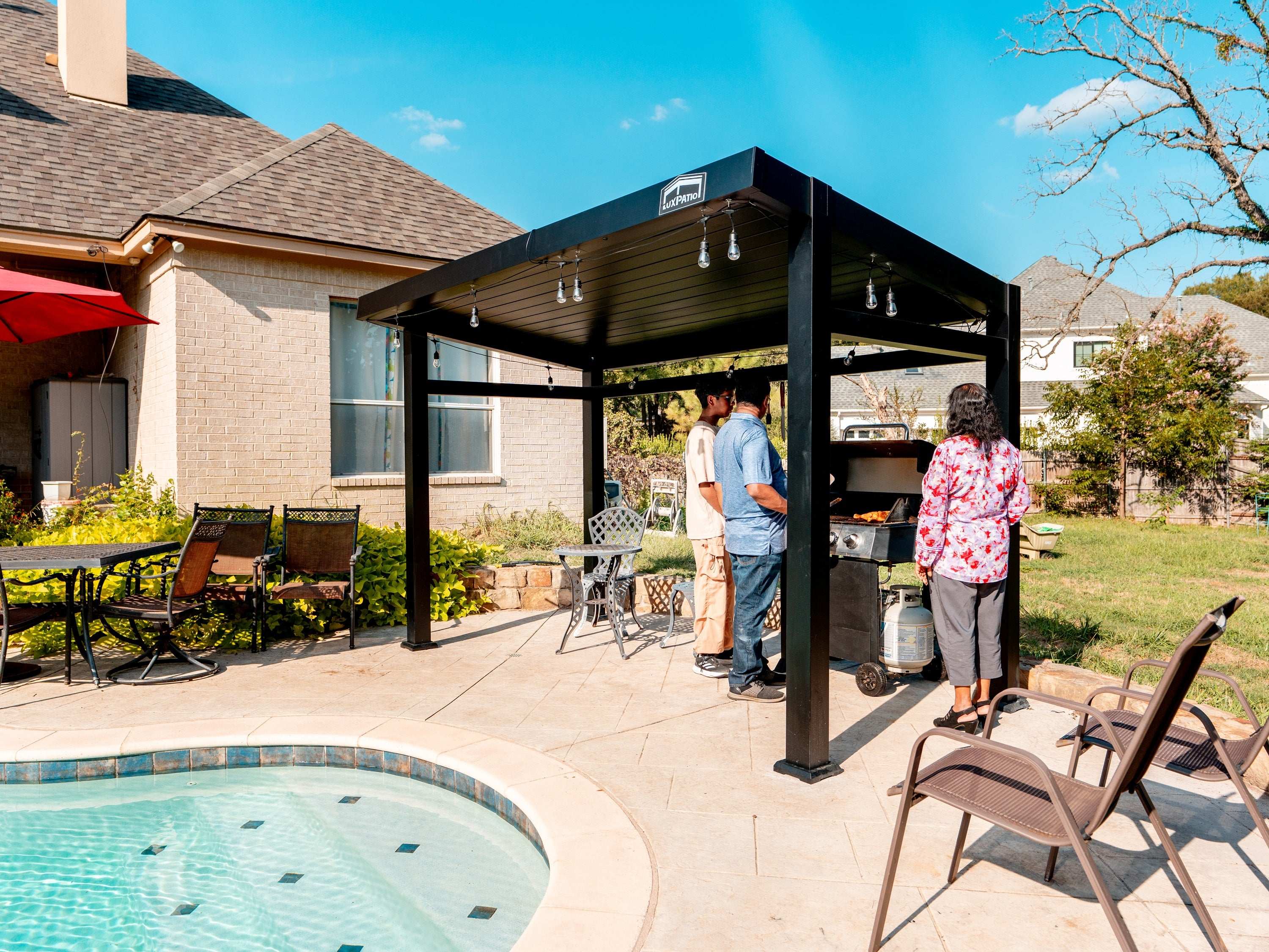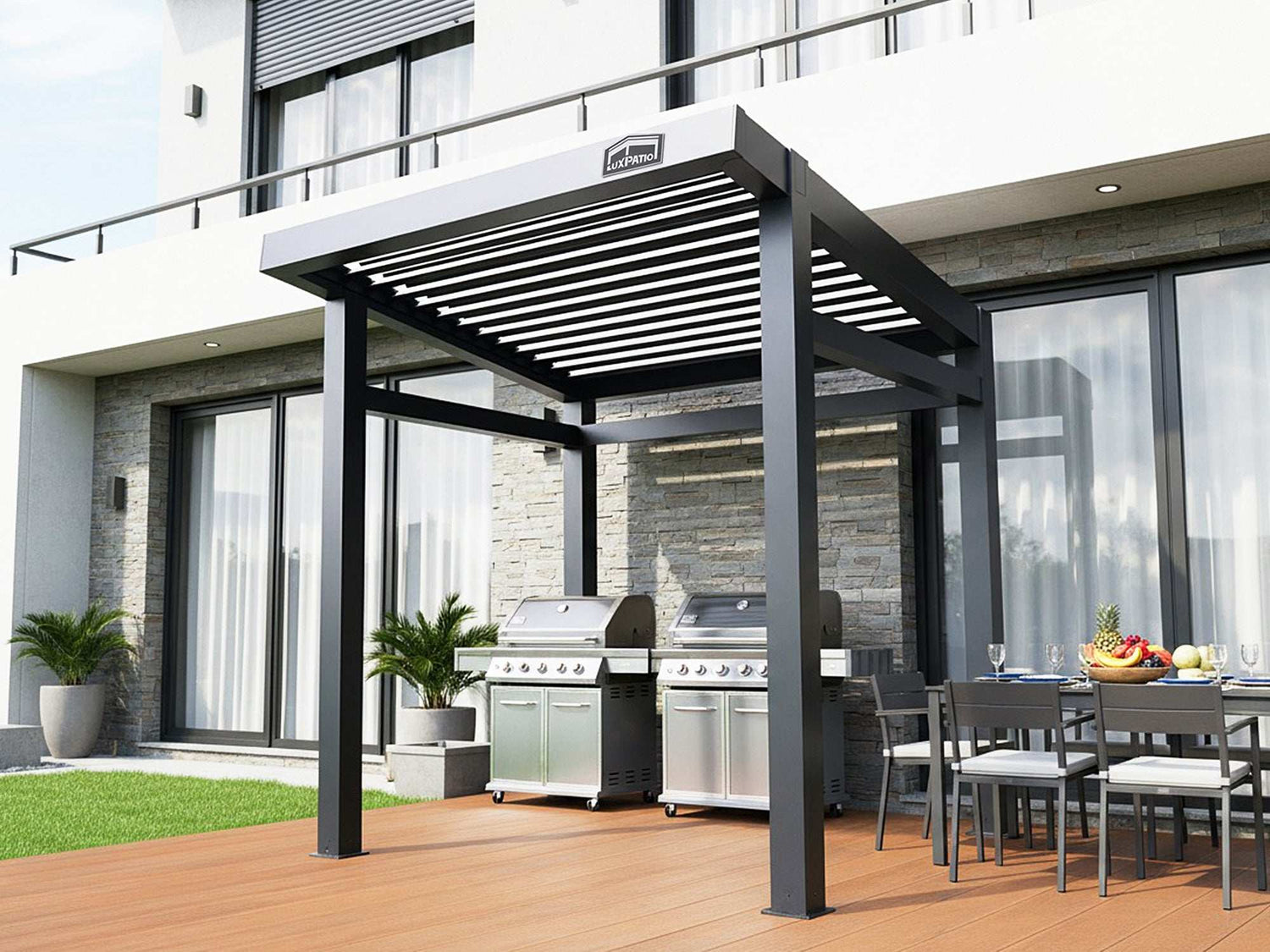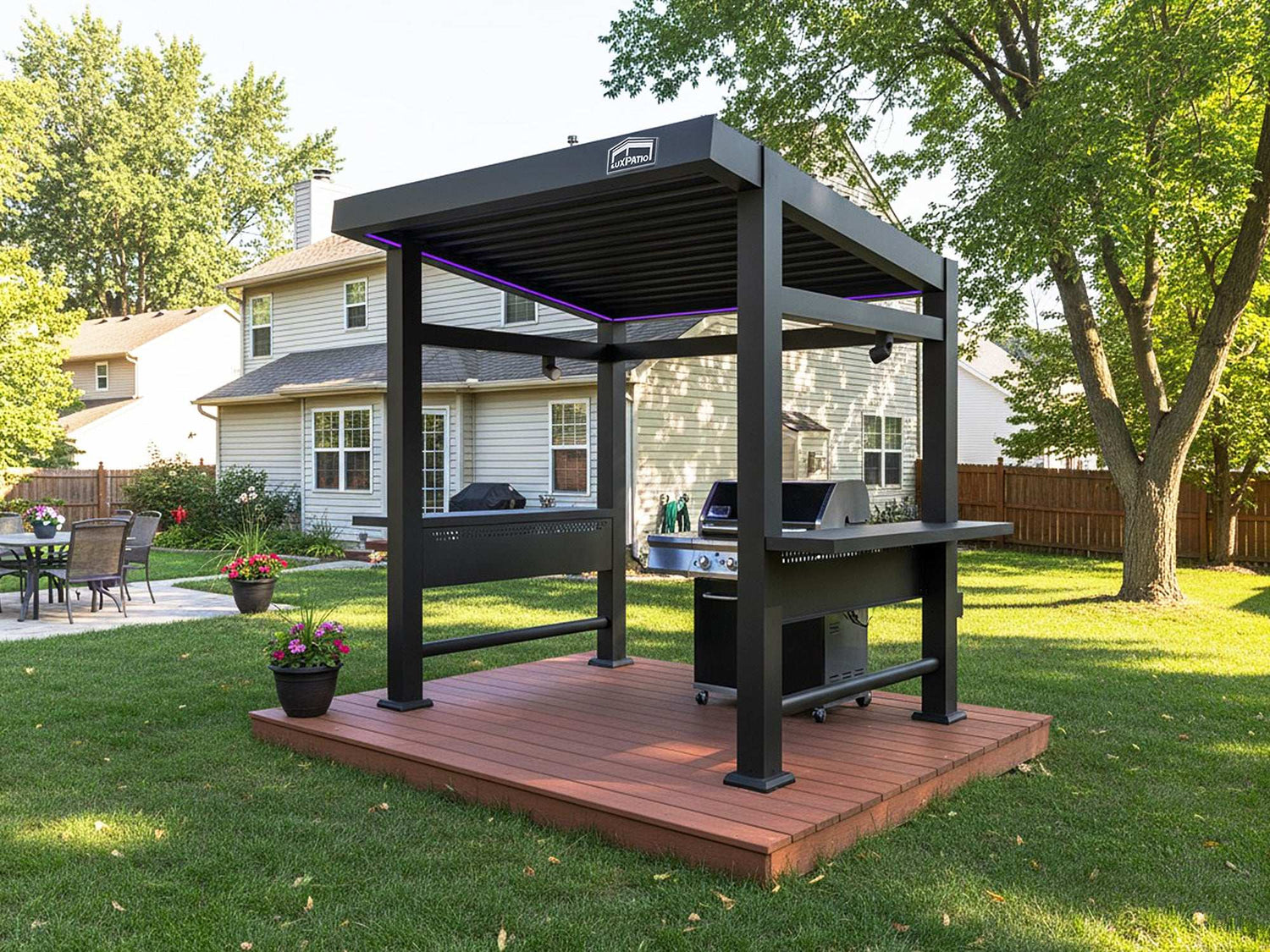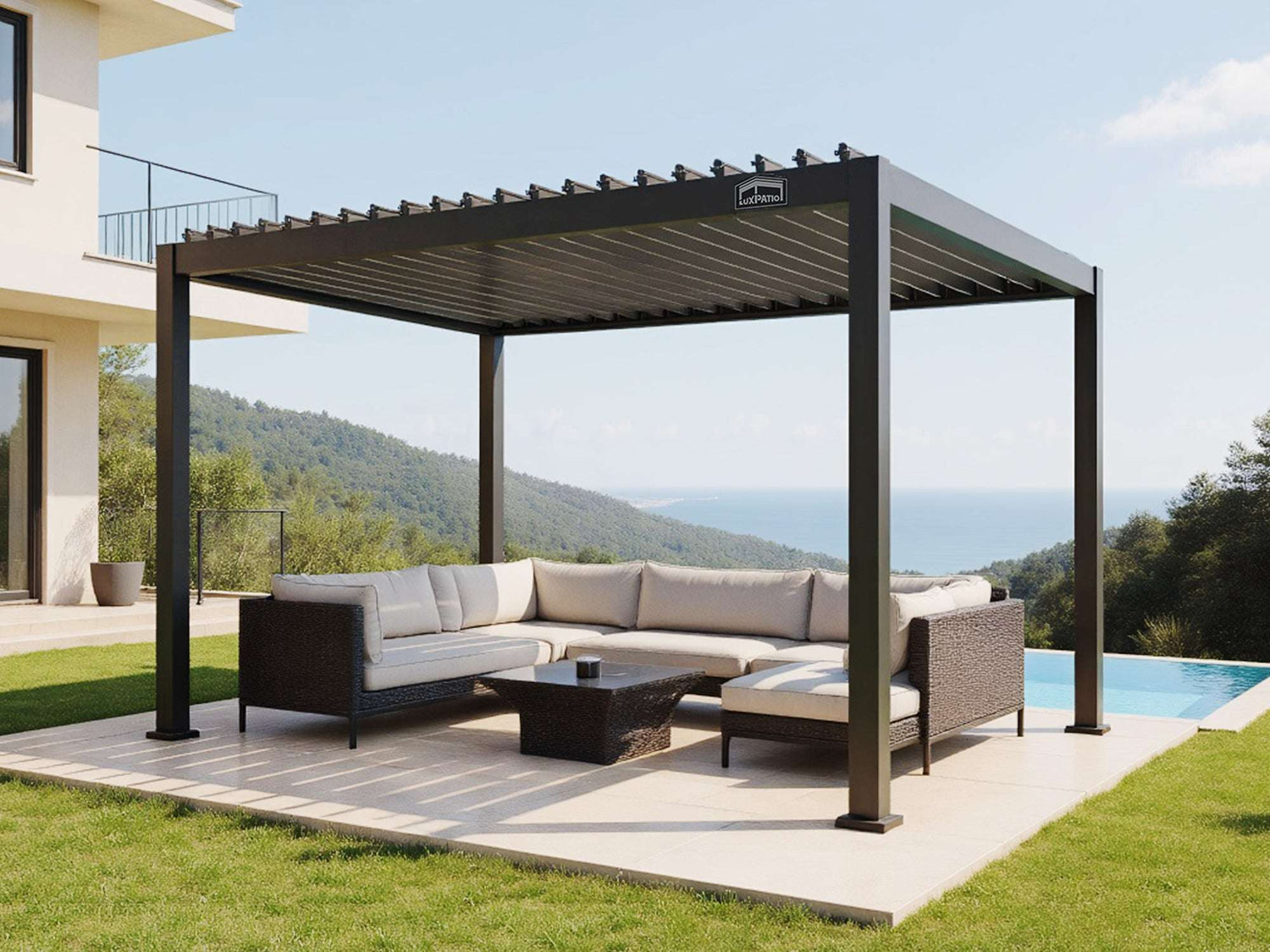Choosing a look for an outdoor space can drag on for weeks. Too many options, too many pins, and still no plan. This guide trims the noise and focuses on three clear directions, then shows exactly how to execute each one with color, furniture lines, lighting, and accessories. You will also see material choices that survive weather and simple rules for comfort. By the end, you can pick from leading patio styles and complete a weekend refresh with confidence.
Choose Your Patio Style
Before you buy anything, make three quick calls. Do you want open calm or layered detail? Do you lean neutral or prefer a small accent color? How much routine care fits your life?
Turn the answers into a direction:
- Calm lines, light volumes, neutral base with a single dark outline point to a minimalist look.
- Soft textures, plants in the lead, and gentle color shifts match a cottage garden direction.
- Relaxed mixing, handmade texture, and a confident accent hue align with a bohemian mix.
Fix one direction. Every choice that follows becomes faster and more coherent.

Minimalist Patio Design
Think of a patio that lets your eyes breathe. Fewer pieces, clearer lines, and one quiet focal point that does the talking. If you want calm without emptiness, the steps below keep things effortless and crisp.
What It Should Feel Like
A composed scene with room to exhale. Surfaces stay simple, volumes stay light, and the gaze moves without snags. The overall impression is tidy and easy on the mind.
Palette You Can Copy
Warm White #F5F5F2, Light Gray #D9D9D6, Sand #C2B8A3, Carbon #2B2B2B. Use the first three as the base and let Carbon outline small elements such as the rim of a tray, slim frames, or one dark vessel. Keep that outline to about one-tenth of what you see, so the space never feels heavy.
Furniture and Proportions That Work
- Keep seat height around 16 to 18 inches and seat depth around 20 to 24 inches for a relaxed posture without slouching.
- Choose slim legs or a low plinth so the floor remains visible. That floor reveal keeps a compact patio from feeling crowded.
- Coffee table height around 16 to 18 inches; distance from sofa front to table edge about 14 to 18 inches, so a cup is within easy reach.
- Avoid overstuffed arms and deep tufting. Straight cushions with tight upholstery read cleaner and collect less dust.
Lighting and Accessories
- Two or three plain cushions in one fabric family. Add one sculptural bowl or stone tray for a focal note.
- Ambient light can come from a soft wall wash or a single straight run of string lights. Add one task point by the reading seat.
- Aim for roughly 80 to 150 lumens for ambient spots and 300 to 500 lumens for reading.
Ten-minute Upgrade
Clear the tabletop, add one dark accent, swap mismatched pillows for two identical covers, and run the string lights in a single line. Watch the space settle down in front of you.

Cottage Garden Patio Style
If your idea of comfort includes soft textiles, a hint of scent, and leaves moving in the breeze, this direction fits like a glove. The trick is gentle color and honest materials, then letting plants tell the story.
Palette you Can Copy
Cream #FFF4E6, Sage #B8C2A1, Light Terracotta #D9A679, Mushroom #7A6F63. Cream and Sage form the base. Terracotta shows up on planters or a narrow stripe in textiles. Mushroom grounds small hardware or a side table, so the set does not float.
Furniture and Layout Cues
- Rounded edges feel welcoming. A bench with a curved back or a rocker adds rhythm without visual weight.
- Mix wood and stone. A wood bench paired with a small stone or concrete look table gives balance and handles weather with grace.
- Keep a clear path of 32 to 36 inches so people flow naturally. If you add stepping stones or a small gravel patch, let them guide the eye to seating or a planter cluster.
Planting and Accessories
- Herbs near seating bring life and scent. Lavender or rosemary work beautifully and ask for little.
- Create one tidy cluster of three planters: one large 12 to 14-inch diameter, one medium, one small. Vary height and keep finishes in the same family.
- Textiles can carry simple stripes or tiny floral repeats. One pattern plus one plain fabric is enough for most patios.
Care and Pitfalls
Mud splash stains cushions and lower walls in wet months. Lift textiles off the ground and choose washable covers. Keep the number of decorative objects low. The plants bring detail; you do not need trinkets everywhere.
Ten-minute Upgrade
Add a shallow bird bath, replace one plain cushion with a gentle stripe that echoes Sage, and group three terracotta pots by the bench. Suddenly the area feels alive without clutter.

Bohemian Patio Style Ideas
This is the easygoing lounge friends never want to leave. Mix textures, add one bold hue, and keep the setup flexible so the space reshapes itself when more people arrive.
Palette You Can Copy
Sun baked Neutral #E7D7C9, Peacock Blue #1E5F74, Deep Green #3D5A40, Clay #B67E4E. Keep the neutral on big surfaces. Choose either Peacock Blue or Deep Green as the strong accent. Clay appears on a tray, a throw, or a planter to warm the set.
Seating and Furniture
- Build a flexible circle. Two low lounge chairs, one floor cushion, and one pouf create a social hub that expands when guests show up.
- Choose woven pieces with visible fiber texture, such as jute, rattan, or cotton rope. Frames can be simple wood or matte metal.
- Let the largest rug be at least 5 by 8 feet so the front legs of the seats land on it. Add a second, smaller rug on top at a slight angle for depth.
Layering and Lighting
- Patterns need a neutral buffer. If the rug carries a bold motif, pick solid pillows and a lightly textured throw so the set reads as one story.
- Run string lights around the perimeter or above the seating line, then add a tall floor lamp that pushes light upward. Two heights of glow make faces look warm and keep photos lovely.
Care and Pitfalls
Pattern fights happen quickly. Pick one hero motif and let every other textile support it. Keep the accent color within one family so the composition feels curated rather than chaotic.
Ten-minute Upgrade
Stack two rugs, swap one patterned pillow for a solid that matches your hero tones, and place a tray with tea lights or battery candles at the table center. The mood shifts from random to inviting.

Patio Color Palette and Weatherproof Materials
Outdoor areas are less forgiving than living rooms, so smart choices here save time and money later. Pick colors that hold up in bright light, fabrics that resist UV, and hard surfaces that do not mind a sudden summer storm. Treat the notes below as guardrails rather than rigid rules, then adjust for your climate.
Color Endurance
Low saturation stands up better to the sun. Dark tabletops show dust and water marks quickly, so reserve deep tones for outlines or small vessels. Use your patio color palette to keep choices consistent across textiles, planters, and small furniture.
Outdoor Fabrics
Look for UV-resistant specifications and removable covers. Tight weaves shed debris and clean easily. If you host often, buy an extra set of cushion covers so laundry never blocks use.
Hard Surfaces
Stone and powder-coated metal stay stable outdoors. Unsealed soft wood needs scheduled cleaning and surface protection, especially in coastal or humid zones. These are reliable weatherproof materials for patios that keep maintenance predictable.
Climate Quick Guide
| Climate | Safer choices | Avoid | Routine |
| Coastal or humid | Powder-coated metal, stone, synthetic fibers | Untreated soft wood, porous stone left unsealed in full exposure | Inspect metal quarterly for early rust; clean fabrics monthly |
| Hot and dry with strong sun | Light UV-rated fabrics, shade devices, pale tabletops | Large dark tops that heat up at midday | Swap fabrics seasonally; adjust shade angle with the season |
| Windy or high elevation | Stable low center of gravity furniture, anchoring hardware | Large umbrellas without counterweight | Add weight or anchors; bring textiles in before wind events |
Patio Lighting Ideas and Flow
Night is when a great patio proves itself. Give the whole area a soft base glow, add a few stronger points where you read or prep food, then sprinkle a little sparkle for mood. Leave clear walk paths so people move naturally without bumping a table.
Ambient Layer
Set the base with even light. One straight run of string lights or two gentle wall washes often cover a small space. Keep actual bulbs out of direct sight to avoid glare.
Task Layer
Reading seats and prep zones need stronger points, around 300 to 500 lumens per spot. Place a task light slightly behind and above the shoulder for comfortable pages and chopping boards.
Accent Layer
Candles, lanterns, or a tiny uplight aimed at a plant add a warm edge. Two or three accents are plenty for a compact patio.
Ratings and Safety
Covered zones should reach IP44 or better. Fully exposed fixtures should reach IP65 or better. Use outdoor-rated extension cords and protect every plug connection from standing water.
Flow
Keep a primary path at 32 to 36 inches and avoid placing seating right in the prevailing wind. If guests carry trays, leave generous turning space at table corners and keep cables out of foot traffic.

Accessory Playbook for Patios
Small items shape mood without replacing big pieces, which is ideal for low-maintenance patio decor.
Textiles
Two or three cushions are enough. Combine one pattern with one solid. Choose throws that sit close to the base palette rather than the accent color so harmony stays intact.
Rugs
A 5-by-8-foot rug works for compact seating. A 6.5 by 10-foot rug suits a typical gathering zone. Leave a visible border of the floor so the patio still feels airy.
Planters
Cluster in odd numbers. A large 12 to 14-inch pot stabilizes watering and wind, then add one medium and one small. Keep finishes within one color family for unity, and check that every pot has true drainage.
Seasonal Swap
Summer leans toward lighter textiles and herbs. Fall and winter return to warm whites and thicker textures. A quick swap of covers and a fresh herb set can renew the scene in under an hour.
Personalized Outdoor Decor Plan
You now have a clear map: choose one of the three patio styles, lock a simple palette, keep furniture low and proportionate, light the space in gentle layers, and let a few well-chosen accessories and planters add character. Small, deliberate moves change how the whole patio feels, and they hold up through weather and weekly use.
Ready to bring it to life? Take a quick set of measurements tonight, pick three colors that calm you, and sketch where seating and light should land. This weekend, clear surfaces, place the main pieces, and give the setting a soft evening glow. When you step back, the patio will read as yours. Bookmark this guide for seasonal tweaks, and share your before and after with friends to keep the momentum going.
FAQs
Q1. What drainage slope should a patio have?
Aim for a 1 to 2 percent pitch away from the house, roughly 1/8 to 1/4 inch per foot, toward a drain or edge. Add a linear drain at door thresholds, keep a 1/2 inch step down, and avoid low spots.
Q2. Which slip-resistance ratings are safe outdoors?
Choose exterior tiles or pavers with grippy textures. Look for DIN 51130 R11 or higher, or products tested under ANSI A326.3 for outdoor use. Flamed or bush-hammered stone, ribbed composites, and anti-slip nosing on steps reduce wet-weather risk.
Q3. How should I plan outdoor power safely?
Use GFCI-protected, weather-resistant receptacles on dedicated 20-amp circuits with in-use covers. Keep all boxes and fittings rated for exterior locations. Low-voltage runs typically use 12 to 14 AWG wire. Mount connections off the ground and choose UL-listed transformers.
Q4. How can I improve privacy and cut noise?
Layer soft surfaces and height. Add trellises with dense evergreen vines, outdoor rugs, and cushions. Consider acoustic panels with NRC 0.70 or higher behind seating. A small recirculating water feature around 55 to 65 dB helps mask street noise.
Q5. What should I do for wildfire resilience near the home?
In wildland–urban interface zones, maintain a noncombustible 0 to 5-foot strip next to walls using pavers or gravel. Cover vents with 1/8 inch metal mesh, choose ember-resistant decking or pavers, store cushions on Red Flag days, and clear debris regularly.











